Heinkel He-111 Medium Bomber
Built by Heinkel Flugzeugwerke, the He-111 medium bomber first flew in 1935. Like many other early German aircraft the He-111 was officially designed for more pedestrian purposes in order to comply with the Treaty of Versailles. Notwithstanding the aircrafts' purported peaceful role, it was always meant to be a medium bomber; though it would serve the Luftwaffe in a multitude of roles throughout the Second World War; with over 7,000 built by the end of 1944.
The He-111 was instantly recognizable by virtue of its glass encased nose; providing excellent visibility - though also creating a point of vulnerability exploited by enemy fighters. Produced in several different models, the most common when the Second World War began was the He-111H version (with several variants of the "H" also manufactured). The Luftwaffe had some 700 He-111 bombers of all models combat ready on September 2, 1939. In its traditional bombing role the He-111H came equipped with as many as seven machine guns for defensive firepower and could carry well over 4,000 pounds of bombs. Capable of inflicting substantial punishment, the He-111 was, nevertheless, not a "true" strategic bomber; a fact proven most tellingly during the Battle of Britain.
Picture Courtesy of Deutsches Bundesarchiv (German Federal Archive), Bild 101I-385-0586-16


